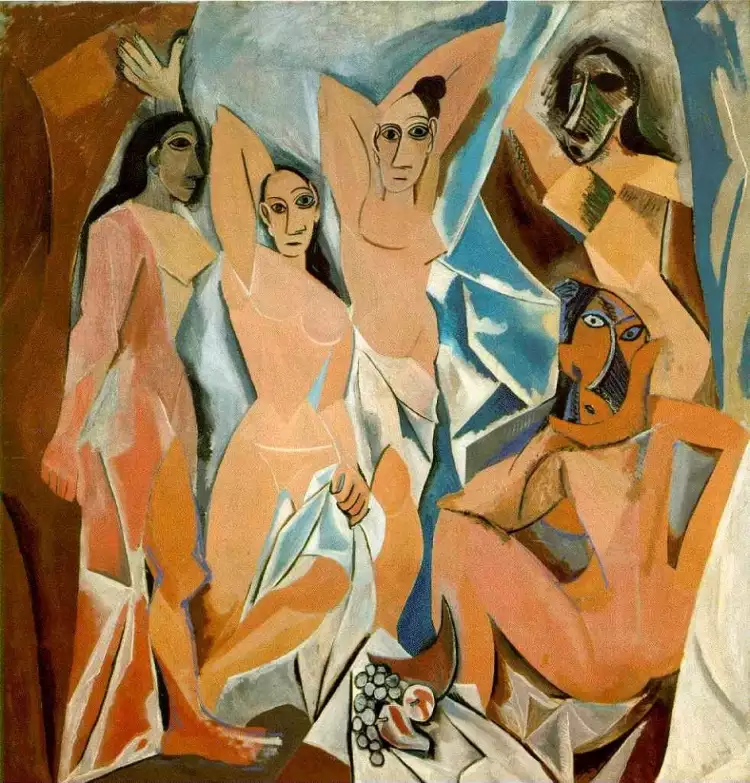
Cubism - a modernist style in 20th-century painting: the essence of the movement, history, and stages of development
Cubism - a style in painting, one of the modernist movements. Cubism originated in France at the beginning of the 20th century. Cubist artists broke down three-dimensional objects into individual elements and transferred them onto a two-dimensional plane. At first glance, Cubism may seem like simplification. However, in the end, Cubists managed to expand the possibilities of human perception of depicted objects. Objects in paintings are depicted as if you are simultaneously viewing them from different angles. This results in the Cubist artists seemingly opening a portal to the fourth dimension by reducing the three-dimensional world to two-dimensionality.
 Cubism. Pablo Picasso. Portrait of Ambroise Vollard, 1910
Cubism. Pablo Picasso. Portrait of Ambroise Vollard, 1910
Cubism allowed painters to represent the properties of artistic objects that couldn't be captured by classical painting methods. Furthermore, new possibilities in color were revealed to artists due to the geometric nature of this new style, allowing for an emphasis on color.
 Cubism. Pablo Picasso, Student, 1919
Cubism. Pablo Picasso, Student, 1919
History of Cubism
Art historians trace the origins of Cubism to the works of Paul Cézanne. Critics recognize the basic principles of the emerging style in his paintings "Mont Sainte-Victoire" and "Mont Sainte-Victoire from Bellevue."
 Cubism. Paul Cézanne. Montagne Sainte-Victoire, 1886
Cubism. Paul Cézanne. Montagne Sainte-Victoire, 1886
The epistolary advice of the master to the young artist Pablo Picasso played a significant role: in their correspondence, Cézanne advised looking at artistic nature as a fusion of basic geometric forms.
Pablo Picasso, who took the recommendations of his senior colleague seriously, became the founder of Cubism. It was in his work that the possibilities of pictorial analysis and synthesis were revealed in a multifaceted way: by breaking down objects into elements, Picasso then constructed a new reality from these "patches."
 Cubism. Pablo Picasso. The Brothel of Avignon, 1907
Cubism. Pablo Picasso. The Brothel of Avignon, 1907
Cubism emerged in 1905-1907. The first canvas that marked the beginning of a new era in the history of painting is considered to be "Les Demoiselles d'Avignon." The name was given to it by the artist Henri Matisse in 1908. Upon seeing Georges Braque's painting titled "Houses at L'Estaque," Matisse uttered the famous phrase: "Bizarreries cubiques!" In translation, it means "What cubes!"
 Cubism. Georges Braque. Houses in l'Estaque, 1908
Cubism. Georges Braque. Houses in l'Estaque, 1908
Directions and Phases of Cubism
Art historians identify three directions, or more precisely, phases of Cubism:
- Cézanne-esque, characterized by a desire for maximum fragmentation into "patches," as well as the use of warm shades for the foreground and cool tones for the background.
- Analytical, distinguished by the merging of form and space, the emergence of intersecting planes, the introduction of chaos, the use of semi-transparent structures, and iridescent colors.
- Synthetic, associated with the work of Juan Gris and known for the use of expressive textures, collages, and patterns.
 Cubism. Juan Gris. Portrait of Picasso, 1912
Cubism. Juan Gris. Portrait of Picasso, 1912
Cubism became one of the most famous painting movements, a kind of manifesto of changes in the creative approach. Paintings by famous Cubist artists are among the most expensive lots at auctions.
 The painting "The Scream" by Edvard Munch is a terrifying prophetic symbol of the 20th century
The painting "The Scream" by Edvard Munch is a terrifying prophetic symbol of the 20th century  The painting "Portrait of T. H. Shevchenko" by Ivan Kramskoy is a belief in humanity that has transcended centuries
The painting "Portrait of T. H. Shevchenko" by Ivan Kramskoy is a belief in humanity that has transcended centuries  Neoclassicism: once again, an alignment with ancient ideals!
Neoclassicism: once again, an alignment with ancient ideals!  Sèvres porcelain
Sèvres porcelain  Navigating the Currents: The Tension Between Vintage and Modern Watches
Navigating the Currents: The Tension Between Vintage and Modern Watches  Emerging Color and Material Trends in Architecture for 2023
Emerging Color and Material Trends in Architecture for 2023  Modernism in painting - a different interpretation of reality
Modernism in painting - a different interpretation of reality  Peredvizhniki: Revolution in Russian Art of the 19th century
Peredvizhniki: Revolution in Russian Art of the 19th century  Top 10 Most Iconic Sculptors in the World
Top 10 Most Iconic Sculptors in the World  Painting: its types, styles, genres, techniques, and history of origin
Painting: its types, styles, genres, techniques, and history of origin